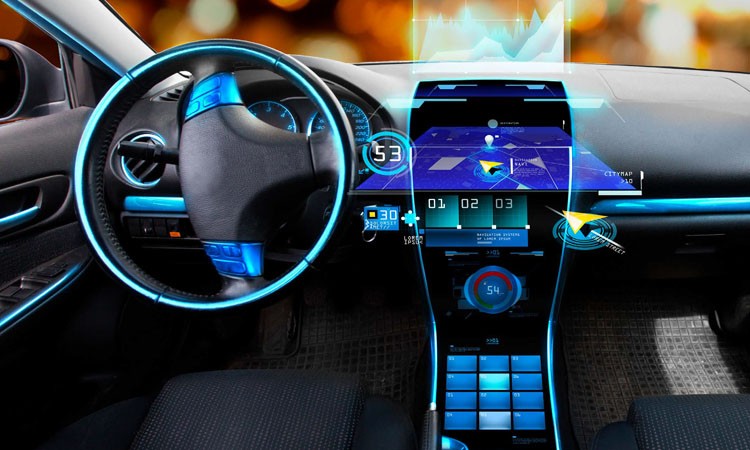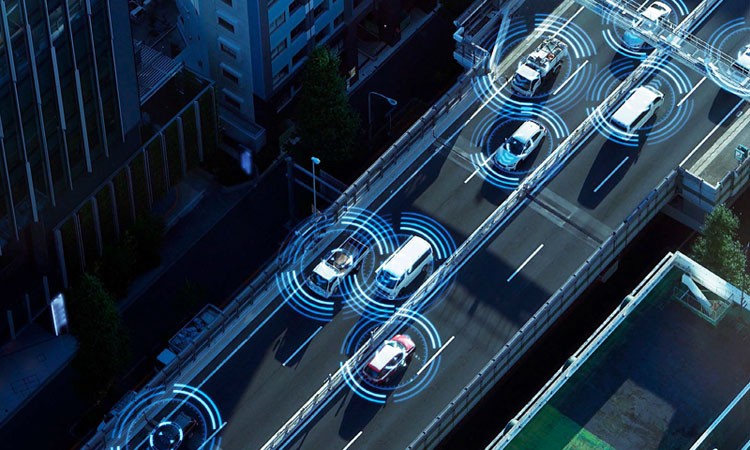White Paper: The Future of Car Interiors is Happening Now
Pressure-sensitive adhesives are helping OEMs revolutionize how we go down the road
Once upon a time (not so long ago, really), car interiors were primarily analog and manual. Windows were rolled down and seats were adjusted by hand. Mirrors were simply rectangles of polished glass that showed what was behind you. Entertainment options were limited to an AM/FM radio and maybe a tape deck — if you didn't like what was playing, you counted license plates. Analog gauges indicated the speed, fuel level, and engine temperature (early digital dashboards emerged in the 1980s but faded out of designs within a decade). Trips were hot in the summer, cold in the winter, and could be uncomfortable and boring.
Modern infotainment systems, LCD screens, Bluetooth® connectivity, heated seats and steering wheels, heads-up displays, satellite navigation, luxurious creature comforts, downloadable performance upgrades and recall fixes, and automatic everything were merely a twinkle in car designers’ eyes. At the time, they seemed as futuristic as interstellar travel and teleportation.
Modern car interiors have evolved dramatically
Well, the future is coming at us fast. Modern cars have evolved dramatically from those of past decades. They stand to evolve even more in years to come. OEMs are finding that plush and electrified interiors — even in modestly-priced cars — are powerful differentiators in a crowded automotive marketplace.
As McKinsey noted in the introduction to its November 2021 report, “The Future of Interior in Automotive,”
Very soon, the cabin experience is expected to take the spotlight away from automotive elements that have traditionally dominated headlines, including engine performance, exterior design and powertrains. The rapidly evolving ACES megatrends — automation, connectivity, electrification, and shared services — will change the configuration of cars and allow vehicle occupants to enjoy new experiences during trips.
The easy-to-remember ACES acronym, mentioned above, was developed by the Center for Automotive Research to define the four key technological trends defining driving in the future.
Automation — Much of driving will one day be managed by the car itself through a combination of sensors tied into a central processor. As the driver will no longer need to focus on the road ahead, interior layouts can undergo radical change. For instance, imagine front bucket seats that can swivel 180 degrees to face the rear seats in a living room-like atmosphere.
Connectivity — Cars will become integrated into our digital ecosystems. Imagine more streamlined connections between our cars, devices, homes, other cars, even the road itself.
Electrification — Even the few modestly-priced electric cars of today have performance characteristics that meet or exceed that of most gasoline-powered vehicles. As powertrain performance becomes less relevant, OEMs will increasingly turn to interior features to differentiate their makes and models.
Shared services — We’re seeing the infancy of shared services today with the popularity of ride-hailing providers such as Uber and Lyft. In the future, the definition of vehicle ownership will become somewhat blurred with the proliferation of services that allow vehicles to be shared by countless riders. Interiors will need not only to be easily customizable to the needs of a broader range of people but have even greater durability.
Design challenges, old and new
Vehicle designers and engineers are working to develop interiors that are in step with these trends. As they push the envelope with technology, solutions must address some critical design challenges:
Design and assembly — Engineers need solutions that are cost-effective, lightweight, durable and easy to work with on an assembly line.
Durability — Solutions must perform at peak levels for the vehicle's lifetime. According to the U.S. Department of Transportation, passenger cars in the U.S. last an average of 12.1 years. This is up from 8.9 years in 2000.
Vision and sensing management — Modern vehicle systems rely on various visual technologies, including radar, lidar, VTX (video transmitter) and view/touchscreens. These technologies must work effectively in a wide range of environments, with varying levels of light and the likelihood of exposure to temperature extremes, chemicals/fuels, road salt and other contaminants.
Unintended consequences — This design revolution has, in turn, created new challenges. Think of them as unintended consequences. For instance, vehicles packed with electronics have increased flammability and electrical arcing concerns. Another challenge is an increase in “buzz, squeak and rattle” issues in EVs caused by the absence of the car’s traditional source of background noise — the internal combustion engine.
Modern interiors feature pressure-sensitive adhesive tapes
Increasingly, engineers are turning to pressure-sensitive adhesive tapes to address these challenges.
Tapes are now used in various interior applications. These include mounting electronic mirrors and displays, bonding positive temperature coefficient (PTC) heaters to warm sensitive electronics, mounting sensors within seats and steering wheels, and as a solution for bonding wire harnesses to interior surfaces.
They’ve gained favor because they address the challenges listed above. Lightweight tapes can replace bulkier mechanical fasteners. They’re easy to apply and are often easily repositionable. Adhesive tapes themselves are long-lasting and can be engineered to resist environmental factors. When paired with specific materials, they can help reduce glare, improve the durability of electronics by sealing and filling gaps, and reduce vibrations and noise.
An opportunity for tape converters
Car interiors have undergone a profound evolution. But as the saying goes, “you ain’t seen nothing yet.” As engineers turn to pressure-sensitive adhesive tapes, opportunities for tape converters will proliferate. Converters can play a critical role by providing lamination of materials; creating multilayer composites; die cutting; and creating part presentations, prototypes and samples.
Now more than ever, the industry needs converters’ expertise and ability to produce these essential materials at scale.
Your next step? Collaborate with Avery Dennison. We bring a 50-year-plus track record in the industry, along with a portfolio of adhesives designed for the needs of the industry, a global reach, R&D capabilities, and an ISO 17025-certified lab and other capabilities.
We’re keen to be on this journey with converters interested in growing in the automotive segment. It’s a journey that — perhaps unlike the road trips of decades past — will be dynamic and full of opportunity.
Contact Avery Dennison to learn more
If you're a converter, automotive tier supplier, or OEM representative looking to better understand the potential for pressure-sensitive adhesive tapes in vehicle interiors, please contact me directly at max.vanraaphorst@averydennison.com.
View our Automotive Electronics portfolio at tapes.averydennison.com/automotivelectronics.



